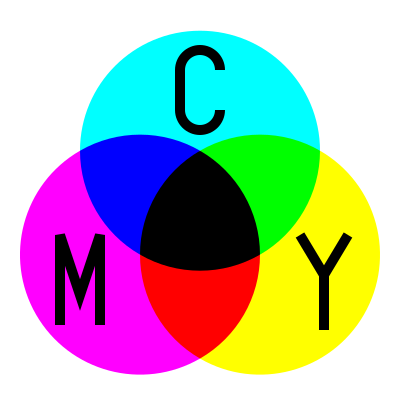Primary colors are sets of colors that can be combined to make a useful range of colors.
The primary colors are Cyan, Magenta and Yellow. The combination of any two primary colors creates a secondary color.
The most commonly used additive color primaries are the secondary color of the most commonly used subtractive color primaries, and vice versa.
Mixing yellow and cyan produces green colors; mixing yellow with magenta produces reds, and mixing magenta with cyan produces blues. In theory, mixing equal amounts of all three pigments should produce grey, resulting in black when all three are applied in sufficient density, but in practice they tend to produce muddy brown colors. For this reason, and to save ink and decrease drying times, a fourth pigment, black, is often used in addition to cyan, magenta, and yellow.
Using red, yellow, and blue as primaries yields a relatively small gamut, in which, among other problems, colorful greens, cyans, and magentas are impossible to mix, because red, yellow, and blue are not well-spaced around a perceptually uniform color wheel. For this reason, modern three- or four-color printing processes, as well as color photography, use cyan, yellow, and magenta as primaries instead. Most painters include colors in their palettes which cannot be mixed from yellow, red, and blue paints. Some who do use a three-color palette opt for the more evenly spaced cyan, yellow, and magenta used by printers, and others paint with 6 or more colors to widen their gamuts. The cyan, magenta, and yellow used in printing are sometimes known as "process blue," "process red," and "process yellow."
Black is the color of objects that do not emit or reflect light in any part of the visible spectrum; they absorb all such frequencies of light. Although black is sometimes described as an "achromatic", or hueless, color, in practice it can be considered a color, as in expressions like "black cat" or "black paint".

White is a color, the perception of which is evoked by light that stimulates all three types of color sensitive cone cells in the human eye in nearly equal amounts and with high brightness compared to the surroundings. A white visual stimulation will be void of hue and grayness.




No comments:
Post a Comment